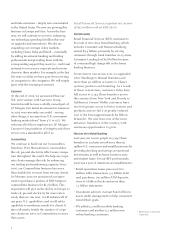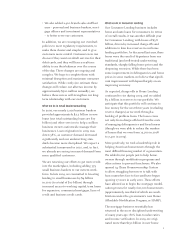JP Morgan Chase 2009 Annual Report Download - page 20
Download and view the complete annual report
Please find page 20 of the 2009 JP Morgan Chase annual report below. You can navigate through the pages in the report by either clicking on the pages listed below, or by using the keyword search tool below to find specific information within the annual report.
18
money while their companies failed and, in
the process, helped contribute to the crisis in
our country. This angers me, too. But not all
companies were reckless – and not all compa-
nies had bad compensation practices.
In this section, I’m going to describe how our
overall 2009 compensation related to other
industries, present some overall principles
that guide us and explain how we apply these
principles in compensating our people.
Comparing JPMorgan Chase with other
industries
In 2009, JPMorgan Chase’s total expenses were
$52 billion. The total compensation (salaries
and benefits and incentives) your company
paid out was $27 billion.
JPMorgan Chase compensation — 2009
Average per
Total employee
(in billions) (in thousands)
Salaries $ 12.5 $ 56
Benefits* 3.9 18
Incentive
compensation** 10.6 46
Total compensation
and benefits*** $ 27.0 $ 120
As seen above, we paid salaries and benefits
of approximately $74,000 per person and
incentive compensation on average of $46,000
per person for a total of $120,000 per person.
These salary and benefit numbers are gener-
ally in line with other major companies –
financial and non-financial.
The incentive awards come in various forms
(cash, commissions, restricted stock, options,
etc.). Approximately 32% of the incentive
compensation for 2009 was in restricted stock
and options that vest over a number of years.
At JPMorgan Chase, the use of stock options
is very restricted – we only use stock options
for approximately 500 people a year – and
represents just 1%-2% of the company’s total
compensation expense.
Many commentators, in an attempt to measure
fairness and reasonableness of a company’s
compensation payouts, have looked at total
compensation as a percentage of revenue. On
this basis, JPMorgan Chase’s total compensa-
tion (salaries, benefits and bonuses) was 27%
for 2009; this number averaged 33% over
the previous several years. For our Invest-
ment Bank alone – the part of the company
receiving the most scrutiny – compensation
was 33% of revenue, down from an average
of 44% over the last ve years.
The chart on the next page compares these
same percentages with a wide mix of busi-
nesses. For the average U.S. business, total
compensation as a percentage of revenue is
approximately 16%. In general, at businesses
that are people-intensive and not capital- or
intellectual property-intensive, such as profes-
sional services companies, a high percentage
of the company’s revenue is paid out to the
employees. Law rms, for example (which
are not included in the following table), pay
out more than 80% of their revenue to their
employees. In highly capital-intensive compa-
nies, like telecommunications or certain
manufacturing companies, payout ratios are
considerably lower.
Some commentators also have looked at total
compensation as a percent of profits. Here you
see a similarly wide range of results.
Essentially, the financial dynamics and struc-
tures of various businesses are very dierent,
and looking at these ratios always will produce
divergent conclusions – they alone do not
reveal very much.
It also is important to point out that at many
companies, a significant amount of incentive
compensation generally is paid regardless
of whether or not the overall company does
well. Many companies pay certain individuals
based on their specific performance (sales and
service employees) and not necessarily on the
performance of the company.
JPMorgan Chase does employ a number of
highly compensated individuals, probably
more than in many other industries – but not
* This includes what JPMorgan
Chase contributes to various
benefits programs (i.e., 401(k)
match, pension, health and
welfare, etc.) and employment-
related taxes.
** Represents 2009 expense based
on U.S. GAAP.
*** While we have 220,000
employees, our health plan
covers 400,000 people,
which includes covered
family members.
























